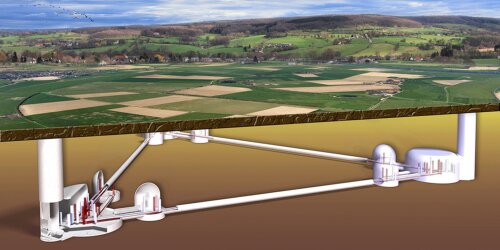The Einstein Telescope is an advanced gravitational-wave observatory, currently in the planning stage. The border region between the Netherlands, Belgium and Germany is being considered as a possible location. This is because of its tranquillity, stable ground and strong ecosystem of scientific institutions and high-tech companies.
Will this new centre for research into the distant universe be located in the region? Scientists, companies and governments in all three countries are exploring the possibilities together.
Scientists plan to use the underground Einstein Telescope to pick up signals emitted just after the Big Bang and to investigate the nature of black holes. This makes it a hugely important instrument for international physics and astronomy. As a challenge for high-tech companies and a driver of technological progress, the project is also a wonderful opportunity for wider society.

The most sensitive gravitational-wave observatory ever
The Einstein Telescope is being designed to be at least ten times more accurate in its measurements than current detectors. This will enable it to explore an area of the universe a thousand times larger in search of gravitational waves, and to detect sources too weak for the current generation of instruments. For the first time, researchers will be able to study the precise structure of neutron stars, the birth of black holes and the structure of the universe immediately after the Big Bang. Using their findings, physicists want to test Einstein’s theory of relativity as never before and gain new insights into our cosmos.
Einstein Telescope

Underground detector
To observe gravitational waves, the Einstein Telescope will measure tiny changes in the length of detector tunnels 200-300 metres underground and several kilometres long. Laser beams shone down the tunnels and reflected back to their source point, normally cancel one another out exactly. When a gravitational wave passes however, the tunnels briefly expand and contract. The light peak thus generated is the wave’s fingerprint and contains information about the source of the signal, such as the formation of a black hole or colliding neutron stars.
The telescope has a design sensitivity of 22 decimal places. This means that it can detect differences in distance ten thousand times smaller than the size of the protons in an atomic nucleus. To achieve that incredible accuracy, the observatory bounces laser beams up and down long tunnels. An ultra-high vacuum and specially designed dampers filter out disruptive vibrations from the immediate environment. The entire technology is quiet, safe and clean: all it does is passively observe and record gravitational waves, which are an existing natural phenomenon.
ETpathfinder testbed
To prepare for the high-tech demands made by the Einstein Telescope, scientists and companies from the Netherlands, Belgium and Germany are setting up a joint R&D facility: ETpathfinder. This is intended to develop precision technology, coatings and optics as well as special measurement and control technology, geotechnics, seismic insulation, IT, engineering , production techniques and materials.